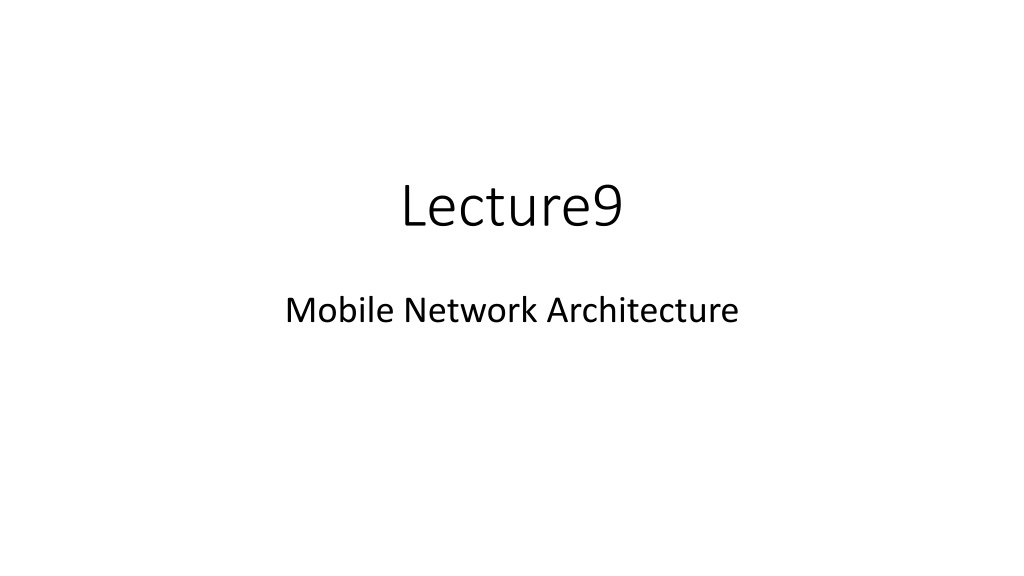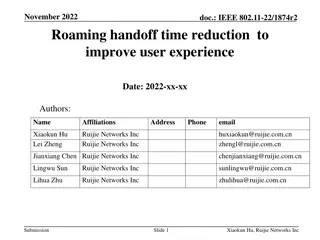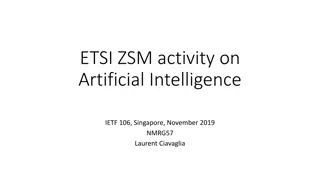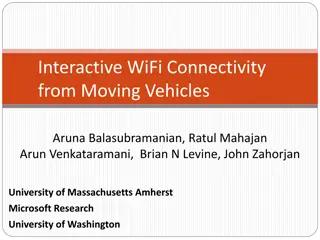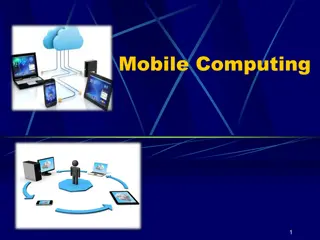Understanding Mobile Network Architecture and Handoff Procedures
The lecture delves into mobile network architecture, discussing fixed and dynamic frequency assignments, as well as handoff processes like hard and soft handoffs. It explains how mobile stations switch between base stations during movement, ensuring seamless communication. Factors impacting handoffs in wireless systems are also explored.
Download Presentation

Please find below an Image/Link to download the presentation.
The content on the website is provided AS IS for your information and personal use only. It may not be sold, licensed, or shared on other websites without obtaining consent from the author. Download presentation by click this link. If you encounter any issues during the download, it is possible that the publisher has removed the file from their server.
E N D
Presentation Transcript
Lecture9 Mobile Network Architecture
Frequency Assignment Fixed frequency assignment: Certain frequencies are assigned to a certain cell. Problem: different traffic load in different cells. Dynamic frequency assignment: Base station chooses frequencies depending on the frequencies already used in neighbor cells. More capacity in cells means more traffic. Assignment can also be based on interference measurements.
Handoff(Handover) Handoff refers to a process of transferring an ongoing call or data session from one channel connected to the core network to another. It may happen that, during a conversation, the mobile station moves from one cell to another. When it does, the signal may become weak. To solve this problem, the MSC monitors the level of the signal every few seconds. If the strength of the signal diminishes, the MSC seeks a new cell that can better accommodate the communication. The MSC then changes the channel carrying the call (hands the signal off from the old channel to a new one).
Hard handoff: break before make connection Early systems used a hard handoff. In a hard handoff, a mobile station only communicates with one base station. When the MS moves from one cell to another, communication must first be broken with the previous base station before communication can be established with the new one.
Soft handoff: Soft handoff: make make- -before before- -break break connection connection New systems use a soft handoff. In this case, a mobile station can communicate with two base stations at the same time. This means that, during handoff, a mobile station may continue with the new base station before breaking off from the old one.
Factors causing handoff/handover in the wireless system: 1. Signal strength/power. 2.Speed of the device/mobile. 3. Weaker signal from serving Base station and strong signals from neighbor base stations. 4. Bit Error Rate. 5. Interference from adjacent channels.
Let us understand types of handoff/handover with respect to GSM system 1. Handoff in the same BTS from one channel to the other 2. Handoff from one BTS to the other BTS (within one BSC) 3. Handoff from one BSC to the other BSC (within one MSC)
Performance metrics Handoff Decision: a number of different performance metrics may be used to make the decision: Call blocking probability: The probability of a new call being blocked, due to heavy load on the BS traffic capacity. In this case, the mobile unit is handed off to a neighboring cell based not on signal quality but on traffic capacity. Call dropping probability: The probability that, due to a handoff, a call is terminated. Call completion probability: The probability that an admitted call is not dropped before it terminates. Probability of unsuccessful handoff: The probability that a handoff is executed while the reception conditions are inadequate. Handoff blocking probability: The probability that a handoff cannot be successfully completed.
Cont.. Handoff probability:The probability that a handoff occurs before call termination. Rate of handoff:The number of handoffs per unit time. Interruption duration: The duration of time during a handoff in which a mobile is not connected to either base station. Handoff delay:The distance the mobile moves from the point at which the handoff should occur to the point at which it does occur.
Decision Network initiated the Handoff decision is made by the network measurements of received signals from the mobile unit. Mobile unit assisted feedback to network for decision.
Handoff Decision: The principal parameter used to make the handoff decision is measured signal strength from the mobile at the BS. Typically, the BS averages the signal over a moving window of time to remove the rapid fluctuations due to multipath effects. Figure 1, shows the average received power level at two adjacent base stations as a mobile unit moves from BS A, at LA, to BS B, at LB. This figure is useful in explaining various handoff strategies that have been used to determine the instant of handoff:
Relative signal strength The mobile unit is handed off from BS A to BS B when the signal strength at B first exceeds that at A. If the signal strength at B subsequently falls below that of A, the mobile unit is handed back to A. In Figure 1, handoff occurs at point L1. At this point, signal strength to BS A is still adequate but is declining. Because signal strength fluctuates due to multipath effects, even with power averaging, this approach can lead to a ping-pong effect in which the unit is repeatedly passed back and forth between two BSs. In other words, the base station with the largest strength is selected (choose BS Bnew if Pnew > Pold).
Relative signal strength (????) LA L1L2 L3 L4LB (b) Hysteresis mechanism a)Handoff decision as a function of handoff scheme Fig Fig 1 1 Handoff between Two Cells Handoff between Two Cells
Handoff Decision: Various strategies, which are used to determine the instant of handoff BSA BSB 0.2 0.4 0.6 0.8 1 1.2 1.4 1.6 1.8 Distance between BS1 and BS2 in miles Fig 2 signal strength of BS1 And BS2
Relative signal strength with threshold Handoff only occurs if :- (1) The signal at the current BS is sufficiently weak (less than a predefined threshold) and (2) The other signal is the stronger of the two. The intention is that so long as the signal at the current BS is adequate, handoff is unnecessary. If a high threshold is used, such as Th1, this scheme performs the same as the relative signal strength scheme. With a threshold of Th2, handoff occurs at L2. If the threshold is set quite low compared to the crossover signal strength (signal strength at L1), such as Th3, the mobile may move far into the new cell (L4) before handoff. This reduces the quality of the communication link and may result in a dropped call. A threshold should not be used alone because its effectiveness depends on prior knowledge of the crossover signal strength between the current and candidate base stations. RSS of a new BS exceeds that of the old BS, RSS of old BS is below a threshold T (choose Bnew if Pnew > Pold and Pold < T).
Relative signal strength with hysteresis Handoff occurs only if the new base station is sufficiently stronger (by a margin H in Figure 1) than the current one. In this case, handoff occurs at L3. This scheme prevents the ping- pong effect, because once handoff occurs, the effect of the margin H is reversed. We can think of the handoff mechanism as having two states. While the mobile is assigned to BS A, the mechanism will generate a handoff when the relative signal strength reaches or exceeds the H. Once the mobile is assigned to B, it remains so until the relative signal strength falls below H, at which point it is handed back to A. The only disadvantage of this scheme is that the first handoff may still be unnecessary if BS A still has sufficient signal strength. RSS of new BS is larger than that of the old BS by a hysteresis margin H (choose Bnew if Pnew > Pold + H).
Relative signal strength with hysteresis and threshold Handoff occurs only if:- (1) The current signal level drops below a threshold, (2) The target base station is stronger than the current one by a hysteresis margin H. In our example, handoff occurs at L3 if the threshold is either Th1 or Th2 and at L4 if the threshold is at Th3. RSS(P) of a new BS exceeds that of the old BS by a hysteresis margin H, and RSS of old BS is below a threshold T (choose Bnew if Pnew > Pold + H and Pold < T)
Prediction techniques: Prediction techniques: The handoff decision is based on the expected future value of the received signal strength.
Types of handoff protocols: 3 types of handoff protocols which help in providing continuous and QoS-guaranteed service. Network-controlled handoff (NCHO). Mobile-assisted handoff (MAHO). Mobile-controlled handoff (MCHO).
Network-controlled handoff (NCHO). In a network-controlled handoff protocol, the network makes a handoff decision based on the measurements of the MSs at a number of BSs. In general, the handoff process (including data transmission, channel switching, and network switching) takes 100 200 ms. Information about the signal quality for all users is available at a single point in the network that facilitates appropriate resource allocation.
Mobile-assisted handoff (MAHO). In a mobile-assisted handoff process, the MS makes measurements and the network makes the decision. In the circuit-switched GSM (global system mobile), the BS controller (BSC) is in charge of the radio interface management. This mainly means allocation and release of radio channels and handoff management. The handoff time between handoff decision and execution in such a circuit-switched GSM is approximately 1 second.
Mobile-Controlled Handoff In mobile-controlled handoff, each MS is completely in control of the handoff process. This type of handoff has a short reaction time (on the order of 0.1 second). MS measures the signal strengths from surrounding BSs and interference levels on all channels. A handoff can be initiated if the signal strength of the serving BS is lower than that of another BS by a certain threshold.
Example: Total of 33MHz bandwidth is available. Cellular phone channel uses 25kHz in simplex mode (i.e. 50kHz in duplex mode). Get the number of channels available per cell if we have 4-cell re-use. If 1 MHz is allocated for control. How many control channels per cell will there be?
- Each duplex channel uses 2x25kHz=50kHz - Total number of channels=33M/50k=660 channels - For 4-cell reuse, channels per cell = 660/4=165 - 1Mhz of control - Total control 1MHz/50k=20 control channels - number of control channels per cell = 20/4 =5, 165- 5=160 voice channels per cell
